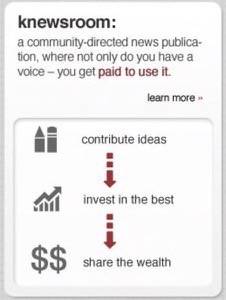The way we create, interact with, and share information on the web is continuously changing, and at a very rapid pace. The end goal, most would argue, is the create a medium that completely democratizes the entire process. This evolution has taken us through editorially driven community sites (Slashdot), socially driven bookmarking sites (del.icio.us), and socially driven news sites (Digg), but none of them have really managed to figure out how to make the newspaper of the future. Just launched Knewsroom, one of the first apps from Kluster (ReadWriteWeb’s coverage), believes that it has gotten it right, but has it really?

This is a guest post by Muhammad Saleem, a social media consultant and a top-ranked community member on multiple social news sites.

“The Knews” gets published every morning, featuring the previous day’s top stories in Politics, Business, Technology, Design, Sports, and Entertainment. — Knewsroom description
You can participate in the Knewsroom in several ways.
1. Propose a topic: Any user can speak up and propose a topic for coverage. The propositions are based on future occurrences that you think will take place, stories that might break, or events you would like to see covered. Once a topic has been proposed, any user from the community can create content based the proposition and you have a chance at getting published and getting paid. This feature works a lot like Newsvine – where you can create a column on your subdomain and get a shot at being featured as a columnist on the front page – but the problem is Knewsroom only shares 20% of its revenue with the community, and that 20% is divided between writers, readers, and evangelists. Newsvine on the other hand, gives columnists 90% of all revenue generated from their columns.
2. Submit or create relevant content: Story submission has two sides to it. First, as mentioned above, you can write original content based on a story someone from the community has proposed, and second, you can submit a link to an external source to be syndicated as a response to the story proposal. If the community deems your content “Knewsworthy,” you will get published on the site’s front page, and if the content is your original work you have the chance to earn an additional $150 on top of your cut from the 20% shared with the community. What you have to do to earn this additional money is not clear (but I imagine it is based on the popularity of the content).
3. Decide what content is deserving: Once a story idea has been proposed and someone else has either created content in response to it or submitted an external link related to it, the Knewsroom community gets to decide whether the story is worth publishing or not. If enough people agree that it is worth covering, it will be published as a column in the next day’s Knewspaper.
What I find really interesting about Knewsroom is that the more you participate and the more the community appreciates and respects your participation, the more power you have to shape the Knews. This is a good way to incentivize regular participation and is the exact opposite of the way Digg treats its most passionate users. As you get more involved, you accumulate watts, a form of currency on Knewsroom, that you can ‘invest’ in proposed topics or created stories to show how much importance you attribute to them and how important you think it is to cover them in the next day’s paper. You accumulate these watts – in the same way you accumulate actual cash on the site – by suggesting topics, writing stories, voting, and referring other members to join the site.

Just like on Wall Street, your return on investment is determined by the risk you take. You can invest in Topics — which are kind of like mutual funds (lower risk/lower return), or you can bet on Stories — which you can think of as individual stocks (higher risk/higher return). Of course, you can diversify and do both. Like everything else at Knewsroom,TM it’s entirely up to you.
At the end of each day (at deadline time), Knewsroom uses its “sophisticated matrix algorithm” to determine what the most important topics are in each category and what the most important stories are within each topic. If your topics or stories are picked, you get a return on the watts you invest as well as real cash credited to your Knewsroom MasterCard.
Problems with Knewsroom
As I was signing up for the service, I immediately saw several issues with it. For example, unlike traditional social news sites Knewsroom’s Knewspaper doesn’t update as people participate on the site and invest watts into stories, rather there is one Knewspaper per day and once it’s published there is no changing it. This feels like a step backwards, toward daily print news cycles where if a news story breaks in the evening you don’t know about it until the next day. It’s as if they’ve taken something static (a print paper) and put it on a dynamic platform (web publishing) but refused to take advantage of the dynamicness.
For example Knewsroom’s coverage in the technology section yesterday had no mention of Yahoo!, Facebook versus Google, CBS’s acquisition of CNET, or any other stories that broke later in the day and were all over Techmeme and Digg almost immediately. In fact, I saw some of these stories in the queue for tomorrow’s paper, by which time they will already be old news.
Furthermore, the revenue sharing, while a good idea, is not enticing enough to attract people already contributing to Newsvine’s social news and content publishing hybrid that pays out a much larger percentage for your efforts. And while I like the idea of ‘investing’ in stories rather than a simple positive or negative vote (because it allows for degrees of approval and also limits how you distribute your watts among stories), the implementation of the feature on the site feels a little contrived. For example, rather than simply submitting a story, you have to first select a category, then pick a topic (or create a topic), then invest in it and hope enough other people do too (not to mention waiting for someone else to find a link to write original commentary on a topic you proposed), before it gets published. And you have until 5:00 AM CST for the entire process to complete, meaning a story that breaks an hour later would have to go through a 23-hour gestation period before it gets published (if at all).
If at first glance you find yourself simply comparing the service to a combination of the existing social news services with a newspaper-style presentation of the content, you’re not far from reality. Knewsroom uses the existing services as models to build on and even though they are moving in the right direction, they have made some grave missteps that keep them from the prize. In the end, it’s the site’s slogan that sets it up for failure…
The best news isn’t up to the minute — it’s up to you.
The problem is, a lot of incredibly important news is up to the minute and if I can’t get it on Knewsroom, I will go somewhere else where I can.










